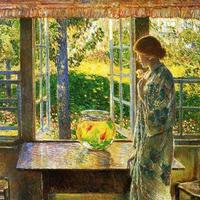The Goldfish Window
Item
-
Name
-
The Goldfish Window
-
Summary
-
Childe Hassam, for more than twenty years one of the country's leading Impressionist painters, began The Goldfish Window at the artists' colony in Cos Cob, Connecticut, in the summer of 1915 or 1916 and finished it in his New York studio in 1916. Hassam worked periodically at Cos Cob between 1894 and 1923, often staying at the famed Holley House, the gathering place for artists. Like a number of other members of the Cos Cob group, Hassam spent winters painting and exhibiting in New York and occasionally returned to France to renew his acquaintance with European styles. His 1910 trip to Paris, while reinforcing his commitment to the impressionists' focus on the effects of light, also renewed his interest in classicism and traditional formal problems. These concerns are paramount in a group of paintings, begun at about the time Hassam went abroad, that came to be known as the Windows series, The Goldfish Window is one of the most successful renderings of the theme.
In these paintings, a contemplative young woman is posed in front of a large window in a handsomely furnished interior, generally with a still-life arrangement on a table beside her. Sunshine pours in, backlighting the figure and creating a halo around her that adds to her ethereal beauty. Most of the Windows pictures were staged in Hassam's Manhattan studio. The Goldfish Window is unusual for having been painted at the Holley House; one of the summer colony's art students may have posed for the picture. The loose kimono in which the model is dressed may have been a studio prop of Hassam's, for other figures in the series wear similar robes. Yet it also reflects the general taste for aestheticism at Cos Cob, where students aspired to Oriental elegance, dressing up in kimonos and practicing flower arranging and tea ceremonies. The combination of Oriental objects (not the least of which is the glass bowl, filled with giant goldfish) with American antiques-the ladder-back, rush-seated chair and mid-eighteenth century, country-type table-is furthermore a reflection of Hassam's Boston roots. Just at this time, such Boston school painters as Frank Benson (q.v.) and Edmund Tarbell (q.v.) were painting similarly contrived, elegantly appointed interiors, with their typically Boston mix of New England antiques and Oriental objets d'art.
Hassam painted the last of the Windows pictures about 1920. They had been an important source of income and critical acclaim for him, winning prizes and selling quickly, quite a number of them to museums. In a 1927 interview, he described his interest in compositions such as these in purely formal terms: "[I enjoyed] using…figures with…flowers in an arrangement to make a beautiful combination of color and line." But as The Goldfish Window makes clear, these are also paintings of mood: the contrast between the brilliant, sunlit garden and the shadowy interior, painted in cool tones, reinforces the contemplative mood of the figure. The carefully structured room suggests both security and confinement, while the model's wistful gaze directs the viewer's eye to the relative freedom of the garden beyond. (Source: Currier Gallery of Art Collection Database)
-
Date
-
1916
-
Dimensions
-
34 3/8 in. x 50 5/8 in. (87.31 cm x 128.59 cm)
-
Provenance
-
Wife of the artist
William Macbeth, Inc., New York, NY
Purchased by Currier Gallery of Art, 1937
-
Identifier
-
1937.2
-
Rights
-



